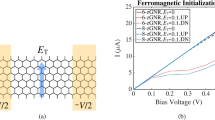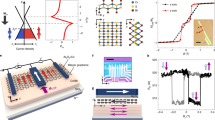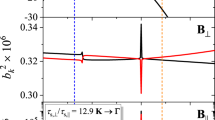Abstract
Graphene has emerged as a versatile material with outstanding electronic properties1,2,3,4 that could prove useful in many device applications. Recently, the demonstration of spin injection into graphene and the observation of long spin relaxation times and lengths have suggested that graphene could play a role in ‘spintronic’ devices that manipulate electron spin rather than charge5,6,7,8. In particular it has been found that zigzag graphene nanoribbons have magnetic (or spin) states at their edges, and that these states can be either antiparallel or parallel9,10,11,12,13,14,15,16. Here we report the results of first-principles simulations that predict that spin-valve devices based on graphene nanoribbons will exhibit magnetoresistance values that are thousands of times higher than previously reported experimental values17,18,19. These remarkable values can be linked to the unique symmetry of the band structure in the nanoribbons. We also show that it is possible to manipulate the band structure of the nanoribbons to generate highly spin-polarized currents.
This is a preview of subscription content, access via your institution
Access options
Subscribe to this journal
Receive 12 print issues and online access
$259.00 per year
only $21.58 per issue
Buy this article
- Purchase on Springer Link
- Instant access to full article PDF
Prices may be subject to local taxes which are calculated during checkout




Similar content being viewed by others
References
Novoselov, K. S. et al. Electric field effect in atomically thin carbon films. Science 306, 666–669 (2004).
Novoselov, K. S. et al. Two-dimensional gas of massless Dirac fermions in graphene. Nature 438, 197–200 (2005).
Zhang, Y. B., Tan, Y. W., Stormer, H. L. & Kim, P. Experimental observation of the quantum Hall effect and Berry's phase in graphene. Nature 438, 201–204 (2005).
Geim, A. K. & Novoselov, K. S. The rise of graphene. Nature Mater. 6, 183–191 (2007).
Hill, E. W., Geim, A. K., Novoselov, K., Schedin, F. & Blake, P. Graphene spin valve devices. IEEE Trans. Magn. 42, 2694–2696 (2006).
Ohishi, M. et al. Spin injection into a graphene thin film at room temperature. Jpn. J. Appl. Phys. 46, L605–L607 (2007).
Tombros, N., Jozsa, C., Popinciuc, M., Jonkman, H. T. & Wees, B. J. V. Electronic spin transport and spin precession in single graphene layers at room temperature. Nature 448, 571–574 (2007).
Cho S., Chen Y. & Fuhrer, M. S. Gate-tunable graphene spin valve. Appl. Phys. Lett. 91, 123105 (2007).
Fujita, M., Wakabayashi, K., Nakada, K. & Kusakabe, K. Peculiar localized state at zigzag graphite edge. J. Phys. Soc. Jpn 7, 1920–1923 (1996).
Okada, S. & Oshiyama, A. Magnetic ordering in hexagonally bonded sheets with first-row elements. Phys. Rev. Lett. 87, 146803 (2001).
Lee, H., Son, Y. W., Park, N., Han, S. W. & Yu, J. J. Magnetic ordering at the edges of graphitic fragments: Magnetic tail interactions between the edge-localized states. Phys. Rev. B 72, 174431 (2005).
Son, Y. W., Cohen, M. L. & Louie, S. G. Half-metallic graphene nanoribbons. Nature 444, 347–349 (2006).
Son, Y. W., Cohen, M. L. & Louie, S. G. Energy gaps in graphene nanoribbons. Phys. Rev. Lett. 97, 216803 (2006).
Yang L., Park, C. Son, Y. W., Cohen, M. L. & Louie, S. G. Quasiparticle energies and band gaps in graphene nanoribbons. Phys. Rev. Lett. 99, 186801 (2007).
Hod, O., Barone, V., Peralta, J. E. & Scuseria, G. E. Enhanced half-metallicity in edge-oxidized zigzag graphene nanoribbons. Nano Lett. 7, 2295–2299 (2007).
Pisani, L. Chan, J. A., Montanari, B. & Harrison, N. M. Electronic structure and magnetic properties of graphitic ribbons. Phys. Rev. B 75, 064418 (2007).
Parkin, S. S. P. et al. Giant tunneling magnetoresistance at room temperature with MgO (100) tunnel barriers. Nature Mater. 3, 862–867 (2004).
Yuasa, S., Nagahama, T., Fukushima, A., Suzuki, Y. & Ando, K. Giant room-temperature magnetoresistance in single-crystal Fe/MgO/Fe magnetic tunnel junctions. Nature Mater. 3, 868–871 (2004).
Chopra, H. D. et al., The quantum spin-valve in cobalt atomic point contacts. Nature Mater. 4, 832–837 (2005).
Williams, J. R., DiCarlo, L. & Marcus, C. M. Quantum hall effect in a gate-controlled p-n junction of graphene. Science 317, 638–641 (2007).
Huard, B. et al. Transport measurements across a tunable potential barrier in graphene. Phys. Rev. Lett. 98, 236803 (2007).
Ozyilmaz, B. et al. Electronic transport and quantum Hall effect in bipolar graphene p-n-p junctions. Phys. Rev. Lett. 99, 166804 (2007).
Datta, S. Electronic Transport in Mesoscopic Systems (Cambridge Univ. Press, 1995).
Nitzan, A. & Ratner, M. A. Electron transport in molecular wire junctions. Science 300, 1384–1389 (2003).
Cheng, D., Kim, W. Y., Min, S. K., Nautiyal, T. & Kim, K. S. Magic structures and quantum conductance of [110] silver nanowires. Phys. Rev. Lett. 96, 096104 (2006).
Kim, W. Y. & Kim, K. S. Carbon nanotube, graphene, nanowire, and molecule based electron and spin transport phenomena using the non-equilibrium Green's function method at the level of first principles theory. J. Comput. Chem. 29, 1073–1083 (2008).
Soler, J. M. et al. The SIESTA method for ab initio order-N materials simulation. J. Phys. Condens. Matter 14, 2745–2779 (2002).
Egelhoff, W. Jr et al. Artifacts in ballistic magnetoresistance measurements (invited). J. Appl. Phys. 95, 7554–7559 (2004).
Hod, O., Peralta, J. E. & Scuseria, G. E. Edge effects in finite elongated graphene nanoribbons. Phys. Rev. B 76, 233401 (2007).
Li, X., Wang, X., Zhang, L., Lee, S. & Dai, H. Chemically derived, ultrasmooth graphene nanoribbon semiconductors. Science 329, 1229–1232 (2008).
Acknowledgements
This work was supported by the Global Research Lab Project (KICOS) and Brain Korea 21. We thank M. L. Cohen, Y.H. Kim, Y. Son, J.H. Shim, B.I. Min, H.W. Lee, S.K. Kwon and A.W. Leonard for reading the manuscript and providing comments. Calculations were performed with KISTI supercomputers.
Author information
Authors and Affiliations
Contributions
W.Y.K. and K.S.K. conceived and designed the simulations. W.Y.K. developed the program code used in the transmission calculations and performed the calculations. W.Y.K. and K.S.K. discussed the results and co-wrote the paper.
Corresponding author
Supplementary information
Rights and permissions
About this article
Cite this article
Kim, W., Kim, K. Prediction of very large values of magnetoresistance in a graphene nanoribbon device. Nature Nanotech 3, 408–412 (2008). https://doi.org/10.1038/nnano.2008.163
Received:
Accepted:
Published:
Issue Date:
DOI: https://doi.org/10.1038/nnano.2008.163
This article is cited by
-
Tunable spin and conductance in porphyrin-graphene nanoribbon hybrids
Communications Physics (2023)
-
Tailoring magnetism in silicon-doped zigzag graphene edges
Scientific Reports (2022)
-
Vacancy tuned thermoelectric properties and high spin filtering performance in graphene/silicene heterostructures
Scientific Reports (2021)
-
Evolution of the electronic structure in open-shell donor-acceptor organic semiconductors
Nature Communications (2021)
-
Pure thermal spin current and perfect spin-filtering with negative differential thermoelectric resistance induced by proximity effect in graphene/silicene junctions
Scientific Reports (2021)



